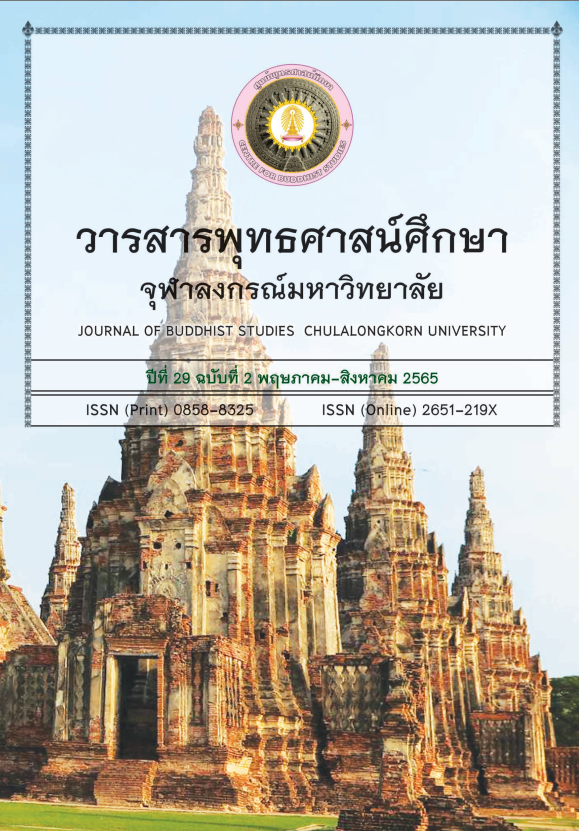A Buddhist Model for Health Promotion in Preventing Drinking and Smoking Among Thai Youth
Keywords:
A Buddhist Model for Health Promotion, alcohol, tobacco, Thai YouthsAbstract
The purpose of this research is to study the application of Buddhist teachings to prevent alcohol consumption and smoking among Thai youths, and to present a Buddhist model of well-being promotion to prevent alcohol consumption and smoking among the same group. This is achieved through qualitative research consisting of documentary research and in-depth interviews with samples of 40 youths from the four regions.
The study found that a reflection on Buddhist concepts and principles revealed an emphasis on the human mind, whose functioning process is more powerful than that of the body. Therefore, it is of utmost importance to start with the youths' “mind."The principle of "Yonisomanasikara" leads the youths to wisdom: correct perception, attitudes and beliefs, and discrimination of good and bad. The principles of "Paratoghosa/Kalyanamitra" help the youths to foster love and confidence in distancing themselves from alcohol and cigarettes. These two principles combined resulted in a Buddhist well-being promotion model based on the youths themselves and on external environmental factors. The youths can be shaped by good living models and moving experiences from close relations. This should be reinforced with a symbolic model – the reflection from the two principles of Buddhist teaching – which enables the youths to believe in their capacities to control themselves.
Downloads
References
กองสถิติสังคม. สำนักงานสถิติแห่งชาติ. (2561). การสำรวจพฤติกรรมการสูบบุหรี่ และการดื่มสุราของประชากร พ.ศ. 2560. กรุงเทพฯ : บริษัท พิมพ์ดีการพิมพ์จำกัด.
เกียรติภูมิ วงศ์รจิต. (2563). กรมสุขภาพจิต เผยวัยรุ่นไทยปรึกษาสายด่วนสุขภาพจิต 1323 ปี 62 พบ “ปัญหาเครียด” มากสุด แนะเทคนิคจัดการความเครียด. สืบค้นจาก http://www.prdmh.com.html.
นิพนธ์ ชินานนท์เวช. (2561). บทบาทภาครัฐ ในการควบคุม เครื่องดื่มแอลกอฮอล์. ประกอบการประชุมวิชาการสุราระดับชาติ ครั้งที่ 10. สืบค้นจาก http://cas.or.th/cas/wp-content/uploads/2019/04/ACFrOgAfyWyxjQOc3VpqFBjXNy488Zh7KCIgyJZ7QU3HpYY5mscG5Mg8OjEkd7VvlhsBrjtop5wOHhcbQffZU5800l_SemtnQhn3IJGoc_blExLBvykLgW37U-uhv643U_C9f5VGha1EjP3jNv2o.pdf
พรจิรา ปริวัชรากุล. (2559). แกะรอยหยักสมอง: มองผลกระทบของการพนัน. กรุงเทพฯ :โครงการขับเคลื่อนสังคมและนโยบายสาธารณะเพื่อลดปัญหาจากการพนัน มูลนิธิสดศรี-สฤษดิ์วงศ์.
รัศมน กัลป์ยาศิริ และคณะ. (2561). การศึกษาระยะยาวแบบไปข้างหน้าในประเทศไทยเกี่ยวกับรูปแบบการใช้และการจัดหาเครื่องดื่มแอลกอฮอล์ บุหรี่ และสารเสพติดของผู้ปกครองในนักเรียนชั้นมัธยมศึกษา. สืบค้นจาก http://cas.or.th/cas/?p=6456
วีโอเอไทย. (2561). องค์การอนามัยโลก เผย 1 ใน 20 คนทั่วโลกเสียชีวิตจากแอลกอฮอล์. สืบค้นจาก https://www.voathai.com/a/who-alcohol-responsible-for-one-in-20-deaths-worldwide/4582056.html
สรวิชญ์ เหล่าอรุณ จิณห์จุฑา และคณะ. (2561). ปัจจัยที่มีอิทธิพลต่อพฤติกรรมป้องกันการใช้สารเสพติด ในนักเรียนโรงเรียนขยายโอกาส. วารสารการพยาบาลและการดูแลสุขภาพ, 36(1), 146-156.
Centers for Disease Control and Prevention, (2020). Smoking & tobacco use: Youth and tobacco use[online], Retrieved from https://www.cdc.gov/tobacco/data_statistics/fact_sheets/youth_data/tobacco_use/index.html
Gordon, R, MacKintosh, A. M. & Moodie, C. (2010). The impact of alcohol marketing on youth drinking behaviour: a two-stage cohort study. Alcohol and Alcoholism, 45 (5), 470–480.
Pettigrew, S. & Donovan, R. (2003). A literature review of the factors that influence alcohol consumption and the effectiveness of past interventions Retrieved from http://www2.curtin.edu.au/research/cbrcc/local/docs/031009.pdf
University of California-Los Angeles. (2011). Tobacco smoking impacts teen’s brains, study shows. Science Daily. Retrieved from https://www.sciencedaily.com/releases/2011/03/110302152820.html
World Health Organization. (2561). Global status report on alcohol and health 2018. Retrieved from https://www.who.int/publications/i/item/9789241565639
Downloads
Published
How to Cite
Issue
Section
License
Copyright (c) 2022 Chulalongkorn University Centre for Buddhist Studies

This work is licensed under a Creative Commons Attribution-NonCommercial-NoDerivatives 4.0 International License.
บทความที่ได้รับการตีพิมพ์เป็นลิขสิทธิ์ของศูนย์พุทธศาสน์ จุฬาลงกรณ์มหาวิทยาลัย
ข้อความที่ปรากฏในบทความแต่ละเรื่องในวารสารวิชาการเล่มนี้เป็นความคิดเห็นส่วนตัวของผู้เขียนแต่ละท่านไม่เกี่ยวข้องกับศูนย์พุทธศาสน์ จุฬาลงกรณ์มหาวิทยาลัย และคณาจารย์ท่านอื่นๆในมหาวิทยาลัยฯ แต่อย่างใด ความรับผิดชอบองค์ประกอบทั้งหมดของบทความแต่ละเรื่องเป็นของผู้เขียนแต่ละท่าน หากมีความผิดพลาดใดๆ ผู้เขียนแต่ละท่านจะรับผิดชอบบทความของตนเองแต่ผู้เดียว






